Others
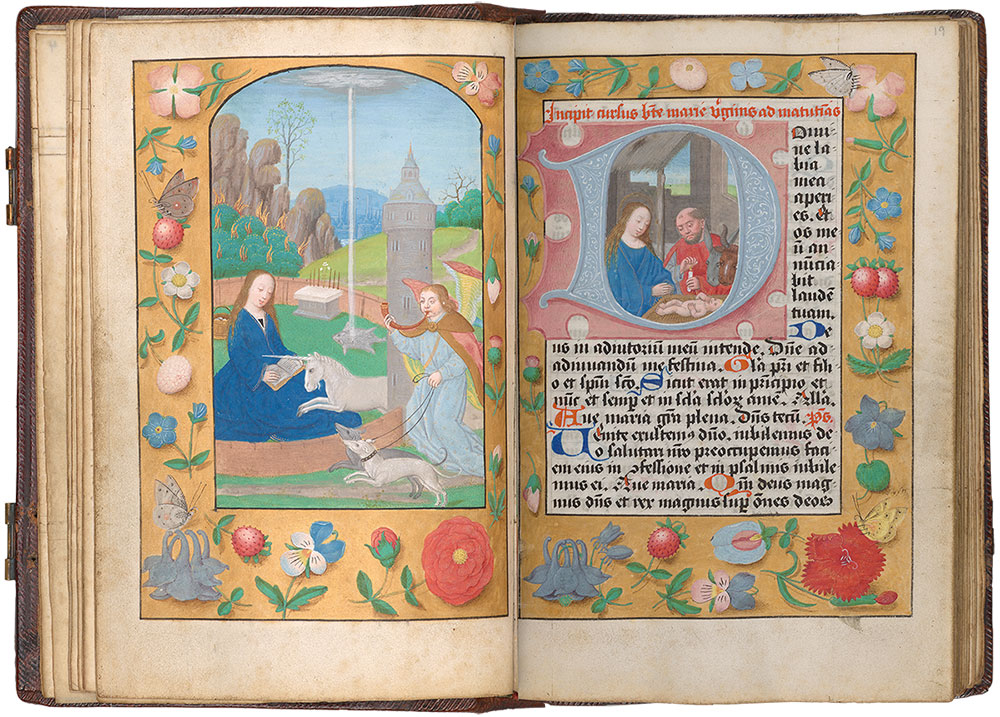
Hunt of the Unicorn Annunciation
Gift of the Trustees of the William S. Glazier Collection, 1984
During the Middle Ages, people believed in unicorns; they are mentioned in the Bible, were discussed by church fathers, and were even seen by travelers. So pervasive was the influence of the medieval hunt that it even invaded Annunciation iconography. Here Gabriel, given the attributes of a hunter, sounds the trumpet, and with the help of two dogs (symbolizing Mercy and Peace) drives the unicorn into the lap of the Virgin. The unicorn is a symbol of the incarnate Redeemer who raised a "horn of salvation" (Psalm 17:3) for the sins of man. The virgin who ensnares him is Mary, his mother, whose virtue he could not resist. The depiction of this allegory, regarded as licentious, was forbidden by the Council of Trent in 1563. This frontispiece to the Hours of the Virgin includes other Marian symbols: the enclosed garden (virginity), Gideon's fleece (a prefiguration of the Annunciation), and the burning bush of Moses and Aaron's flowering rod (both Old Testament events prefiguring the virgin birth, the subject in the initial D on the opposite page).
MS M.445, fols. 202v–3
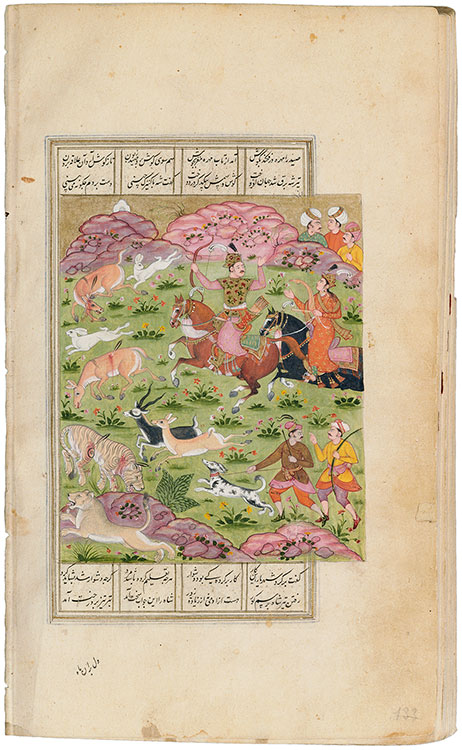
Khamsa (The Quintet), in Persia
Purchased by J. Pierpont Morgan (1837–1913) in 1910
Bahram Gur's Trick Shot
Bahram Gur was a Sassanian king (r. 430–38) whose renown as a great lover and hunter inspired many stories. A section of Nizami's popular Khamsa, devoted to the king's exploits, relates the following. One day, while hunting with Fitna, his harpist slave girl, he felled both a tiger and an onager, but she was not impressed, attributing the result to many years of training. She then challenged him to pin an onager's hind hoof to its ear. Two arrows were required for the trick. The first grazed the animal's ear, causing it to raise its foot to scratch it, while the second quickly pinned the hoof to its ear. Coincidentally, Bahram's nickname, Gur, is the Persian name for "onager," a wild ass. At the bottom right, two hunters approach the felled tiger; the trick shot is depicted at the upper left.
MS M.458.4r
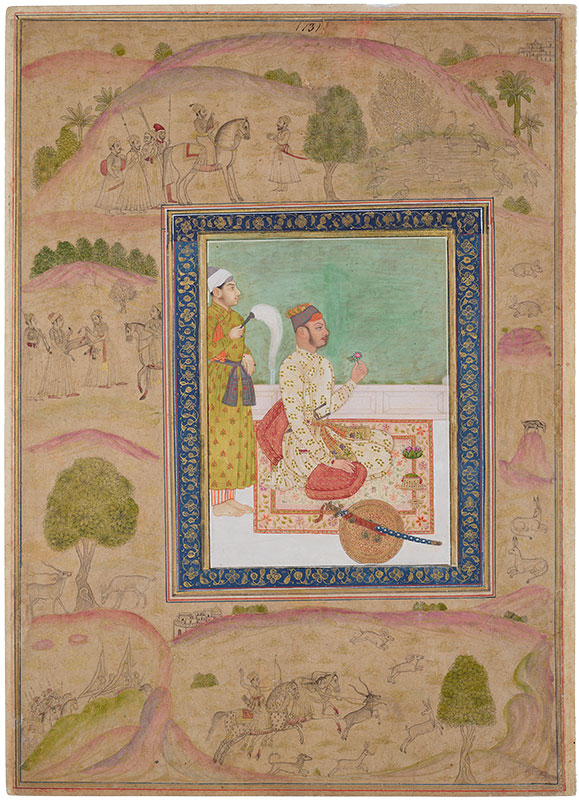
A seated nobleman holding a pink flower
Leaf from the Read Albums
Purchased by J. Pierpont Morgan (1837–1913) in 1911
In this portrait, the border scenes, by a different artist, were deemed appropriate because they attest to the subject's aristocratic status by suggesting that he, too, engaged in similar hunting activities. The seated nobleman holding a pink has not been identified; before him are a long sword and shield, golden spittoon, open pan box, and more flowers in a basket. His attendant holds a fly whisk. In the top border, a falconer learns the location of the prey from a scout, while at the bottom an equestrienne helps out by lassoing the neck of a gazelle with her bow. But most intriguing is the group of female hunters dressed as men on the left, one of whom has shot the young doe held by the others. The woman on the left holds a firearm, the weapon that ultimately transformed the nature of the medieval hunt.
MS M.820, fols. 11v–12
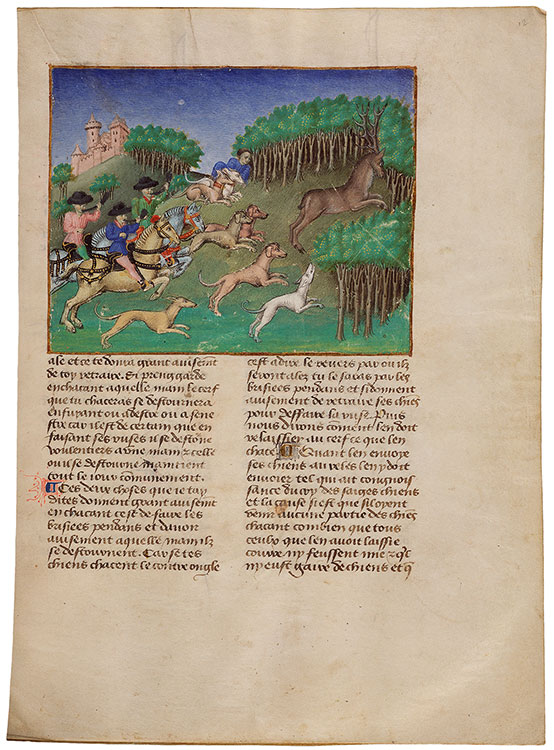
Le Livre du roi Modus et de la reine Ratio, in French
Illuminated by the Master of the Vienna Roman de la Rose
Purchased, 1947
Henri de Ferrières, a Norman nobleman, finished his allegorical hunting treatise, Le Livre du roi Modus et de la reine Ratio, about 1370. To judge by the number of surviving manuscripts (36) and printed editions (8) of "King Method and Queen Reason," the work remained popular until at least 1560. It was the first cynegetic manual in French and provided the model for Phoebus's Livre de la chasse. The Roi Modus, however, also included a large section on falconry. A copy of the present manuscript was used for the first printed edition in 1486, the woodcuts of which are also related to the cycle of miniatures in the manuscript. The text accompanying this chase advises the hunter to observe the directions of the turns taken by the stag, for they would consistently turn to the right or left. According to Queen Reason, hunting helped man to recover the five senses given to Adam, which were originally superior to those of animals but were lost with his downfall.
PML 150046
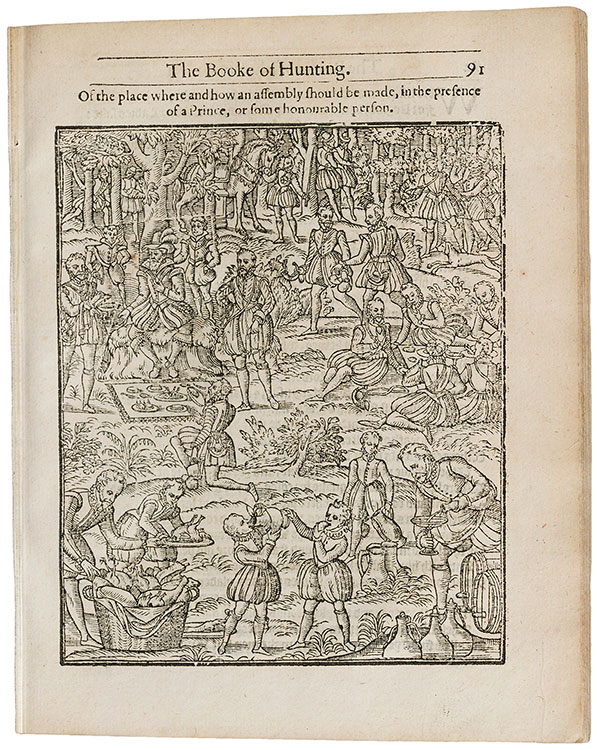
The Noble Art of Venerie or Hunting
London: Printed by Thomas Purfoot, 1611
Bequest of Miss Julia P. Wightman
Pigeon pies, cold mutton, capon, beef, and goose were just some of the dainties provided for this hunting party. Gascoigne eloquently described the lavish refreshments enjoyed by the royal retinue as part of a political allegory designed to demonstrate the brilliance of the Elizabethan court, not just on formal state occasions but even in the great outdoors. This second edition appeared after Elizabeth had been succeeded by James I. Instead of paying for new illustrations, the publisher retained the woodcuts of the first edition and commissioned a hack artist to cut out the portraits of the queen and to insert the figure of the reigning monarch in the proper place.